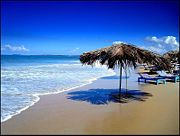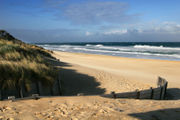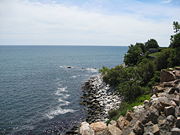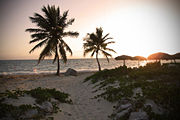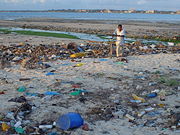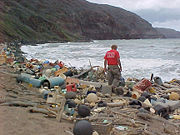Beach
2008/9 Schools Wikipedia Selection. Related subjects: Geology and geophysics
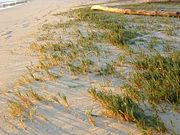
A beach is a geological landform along the shoreline of a body of water. It usually consists of loose particles which are often composed of rock, such as sand, gravel, shingle, pebbles, or cobble. The particles of which the beach is composed can sometimes instead have biological origins, such as shell fragments or coralline algae fragments.
Beaches often occur along coastal areas, where wave or current action deposits and reworks sediments.
Although the seashore is most commonly associated with the word "beach".
- small systems in which the rock material moves onshore, offshore, or alongshore by the forces of waves and currents; or
- geological units of considerable size.
The former are described in detail below; the larger geological units are discussed elsewhere under bars.
There are several conspicuous parts to a beach, all of which relate to the processes that form and shape it. The part mostly above water (depending upon tide), and more or less actively influenced by the waves at some point in the tide, is termed the beach berm. The berm is the deposit of material comprising the active shoreline. The berm has a crest (top) and a face — the latter being the slope leading down towards the water from the crest. At the very bottom of the face, there may be a trough, and further seaward one or more longshore bars: slightly raised, underwater embankments formed where the waves first start to break.
The sand deposit may extend well inland from the berm crest, where there may be evidence of one or more older crests (the storm beach) resulting from very large storm waves and beyond the influence of the normal waves. At some point the influence of the waves (even storm waves) on the material comprising the beach stops, and if the particles are small enough (sand size or smaller), winds shape the feature. Where wind is the force distributing the grains inland, the deposit behind the beach becomes a dune.
These geomorphic features compose what is called the beach profile. The beach profile changes seasonally due to the change in wave energy experienced during summer and winter months. The beach profile is higher during the summer due to the gentle wave action during this season. The lower energy waves deposit sediment on the beach berm and dune, adding to the beach profile. Conversely, the beach profile is lower in the winter due to the increased wave energy associated with storms. Higher energy waves erode sediment from the beach berm and dune, and deposit it off shore, forming longshore bars. The removal of sediment from the beach berm and dune decreases the beach profile.
The line between beach and dune is difficult to define in the field. Over any significant period of time, sand is always being exchanged between them. The drift line (the high point of material deposited by waves) is one potential demarcation. This would be the point at which significant wind movement of sand could occur, since the normal waves do not wet the sand beyond this area. However, the drift line is likely to move inland under assault by storm waves.
Beach formation
Beaches are deposition landforms, and are the result of wave action by which waves or currents move sand or other loose sediments of which the beach is made as these particles are held in suspension. Alternatively, sand may be moved by saltation (a bouncing movement of large particles). Beach materials come from erosion of rocks offshore, as well as from headland erosion and slumping producing deposits of scree. Some of the whitest sand in the world, along Florida's Emerald Coast, comes from the erosion of quartz in the Appalachian Mountains. A coral reef offshore is a significant source of sand particles.
The shape of a beach depends on whether or not the waves are constructive or destructive, and whether the material is sand or shingle. Constructive waves move material up the beach while destructive waves move the material down the beach. On sandy beaches, the backwash of the waves removes material forming a gently sloping beach. On shingle beaches the swash is dissipated because the large particle size allows percolation, so the backwash is not very powerful, and the beach remains steep. Cusps and horns form where incoming waves divide, depositing sand as horns and scouring out sand to form cusps. This forms the uneven face on some sand shorelines.
There are several beaches which are claimed to be the "World's longest", including Cox's Bazar, Bangladesh (120 km), Fraser Island beach, 90 Mile Beach in Australia and 90 Mile Beach in New Zealand and Long Beach, Washington (which is about 30km). Wasaga Beach, Ontario on Georgian Bay claims to have the world's longest freshwater beach. But the longest beach in the world is in fact Praia do Cassino, a 240km long beach located in southern Brazil, near the border with Uruguay.
Beaches and recreation
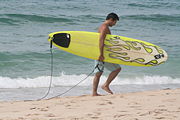
In the Victorian era, many popular beach resorts were equipped with bathing machines because even the all-covering beachwear of the period was considered immodest. This social standard still prevails in many Muslim countries. At the other end of the spectrum are topfree beaches and nude beaches where clothing is optional or not allowed.
A walk along the beach is also popular, including a long walk in the case of a long beach, for example from one seaside resort to the next. When and where the sand is not too hot, people often walk barefoot on the beach, because of the pleasant feeling of sand on their soles and between their toes. The best beach walking areas typically are near the shoreline, where the sand is wet and more comfortable to walk in. A person will also enjoy walking with their bare feet in the water.
In more than thirty countries in Europe, South Africa, New Zealand, Canada, Costa Rica, South America and the Caribbean, the best recreational beaches are awarded Blue Flag status, based on such criteria as water quality and safety provision. Subsequent loss of this status can have a severe effect on tourism revenues.
Due to intense use by the expanding human population, beaches are often dumping grounds for waste and litter, necessitating the use of beach cleaners and other cleanup projects. More significantly, many beaches are a discharge zone for untreated sewage in most underdeveloped countries; even in developed countries beach closure is an occasional circumstance due to sanitary sewer overflow. In these cases of marine discharge, waterborne disease from fecal pathogens and contamination of certain marine species is a frequent outcome.
Beach tokens
Beach tokens, a form of season pass admission ticket, may be required for entrance, for people and even pets. They are made of metal etc. durable material, to enable them to withstand swimming, so the bearer can just carry them around his neck or on his swimsuit. Goals may be:
- restricting to only community members
- user fees for lifeguards, clean up
Artificial beaches
Some beaches are artificial; they are either permanent or temporary (For examples see Monaco, Paris, Rotterdam, Toronto, Hong Kong and Singapore).
The soothing qualities of a beach and the pleasant environment offered to the beach goer are replicated in artificial beaches, such as "beach style" pools with zero-depth entry and wave pools that recreate the natural waves pounding upon a beach. In a zero-depth entry pool, the bottom surface slopes gradually from above water down to depth. Another approach involves so-called urban beaches, a form of public park becoming common in large cities. Urban beaches attempt to mimic natural beaches with fountains that imitate surf and mask city noises, and in some cases can be used as a play park.
Beach nourishment involves pumping sand onto beaches to improve their health. Beach nourishment is common for major beach cities around the world; however the beaches that have been nourished can still appear quite natural and often many visitors are unaware of the works undertaken to support the health of the beach. Such beaches are often not recognized as artificial.
A concept of IENCE has been devised to describe investment into the capacity of natural environments. IENCE is Investment to Enhance the Natural Capacity of the Environment and includes things like beach nourishment of natural beaches to enhance recreational enjoyment and snow machines that extend ski seasons for areas with an existing snow economy developed upon a natural snowy mountain. As the name implies IENCE is not quite mainstream natural science as its goal is to artificially invest into an environment's capacity to support anthropogenic economic activity. An artificial reef designed to enhance wave quality for surfing is another example of IENCE. The Surfrider Foundation has debated the merits of artificial reefs with members torn between their desire to support natural coastal environments and opportunities to enhance the quality of surfing waves. Similar debates surround Beach nourishment and Snow cannon in sensitive environments.
Beaches as habitat
A beach is an unstable environment which exposes plants and animals to changeable and potentially harsh conditions. Some small animals burrow into the sand and feed on material deposited by the waves. Crabs, insects and shorebirds feed on these beach dwellers. The endangered Piping Plover and some tern species rely on beaches for nesting. Sea turtles also lay their eggs on ocean beaches. Seagrasses and other beach plants grow on undisturbed areas of the beach and dunes.
Ocean beaches are habitats with organisms adapted to salt spray, tidal overwash, and shifting sands. Some of these organisms are found only on beaches. Examples of these beach organisms in the southeast US include plants like sea oats, sea rocket, beach elder, beach morning glory aka Ipomoea pes-caprae, and beach peanut, and animals such as mole crabs aka Hippoidea, coquina clams aka Donax, ghost crabs, and white beach tiger beetles.
